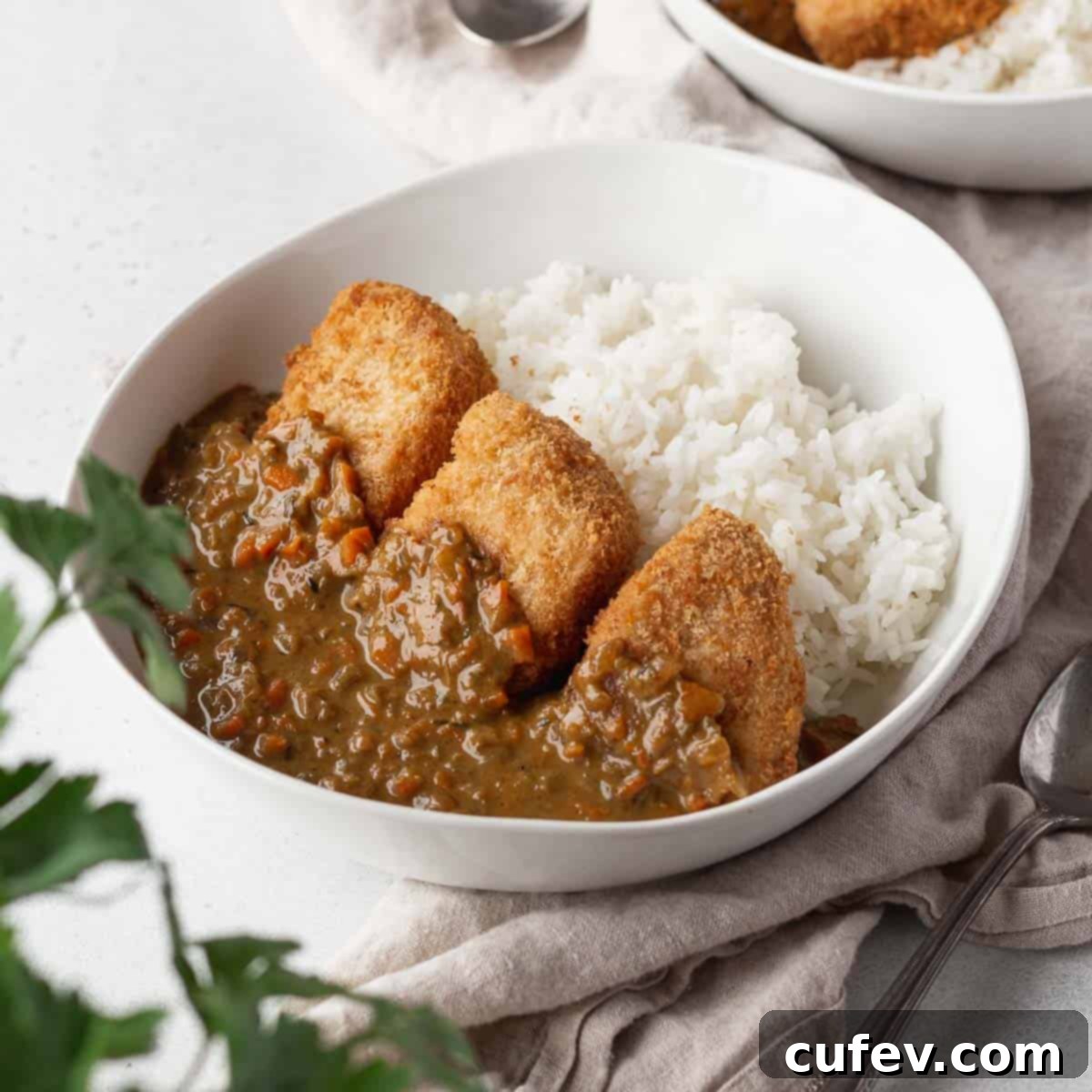Ultimate Vegan Katsu Curry: Crispy Jackfruit, Rich Sauce & Authentic Japanese Flavors
Prepare to indulge in the ultimate plant-based comfort food with this incredible Vegan Katsu Curry (カツカレー) recipe. This dish brings together piping hot, fluffy steamed rice, perfectly crunchy, deep-fried vegan katsu, and a deeply savory, aromatic Japanese curry sauce. Whether you follow a vegan diet or simply appreciate delicious, hearty meals, this recipe promises to be a new favorite. It’s a culinary journey to Japan, reimagined with wholesome, plant-based ingredients, ensuring every spoonful is packed with satisfying textures and robust flavors that will leave you craving more.
This post is proudly sponsored by Chef’s Choice and Nature’s Charm. All opinions and culinary experiences shared in this post are authentically my own.
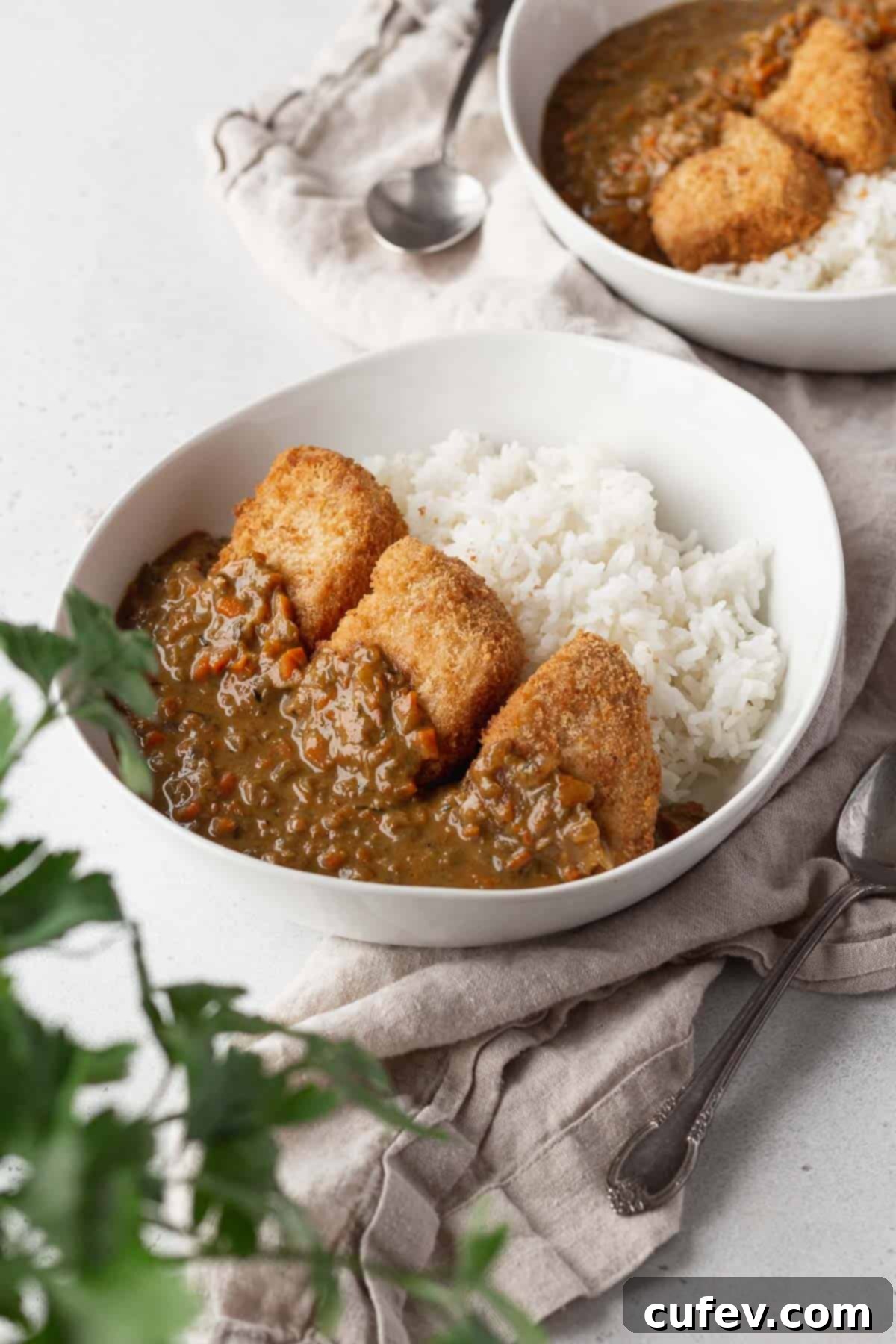
Table of Contents
- What is Japanese Katsu Curry?
- Why is it Called Katsu?
- Why You’ll Adore This Vegan Japanese Curry
- Essential Ingredients for Vegan Katsu Curry
- Smart Ingredient Substitutions
- Step-by-Step Guide: How to Make Vegan Katsu Curry
- Crafting the Rich Vegan Japanese Curry Sauce
- Preparing the Crispy Vegetarian Katsu
- Exciting Recipe Variations for Your Palate
- Expert Pro-Tips for Perfect Vegan Katsu Curry
- Delicious Serving Suggestions
- Frequently Asked Questions About Vegan Katsu Curry
- Storing and Reheating Your Katsu Curry
- Tools You’ll Need for This Recipe
- More Delightful Vegan Japanese Recipes
What is Japanese Katsu Curry?
Japanese Katsu Curry is a beloved yōshoku dish, a fascinating category of Western-inspired Japanese cuisine that has been lovingly adapted and integrated into the local culinary landscape. At its core, katsu curry combines the comforting flavors of Japanese curry with a crispy, breaded cutlet. Traditionally, this cutlet is often pork (tonkatsu), but chicken is also a popular choice, especially outside of Japan.
The magic of katsu curry lies in its harmonious blend of textures and tastes: the fluffy, steaming rice provides a neutral base, while the rich, slightly spicy, and often subtly sweet curry sauce delivers an explosion of umami. Topping it all is the star — a perfectly deep-fried cutlet, encased in a golden, unbelievably crunchy panko breading. This symphony of soft rice, luscious curry, and tender-crisp katsu creates a profoundly satisfying and utterly delicious meal.
My own fond memories of katsu curry trace back to my grandmother’s restaurant in Japan, where the aroma of freshly fried katsu and simmering curry filled the air. There’s an undeniable charm and comfort in a piping hot plate of this classic dish, a feeling we aim to replicate and elevate with our vegan version.
Why is it Called Katsu?
The term “katsu” is a shortened form derived from the English word “cutlet,” which is pronounced as katsuretsu (カツレツ) in Japanese. When this Western cooking technique of breading and frying meat was introduced to Japan, it quickly gained popularity. Initially, beef and chicken cutlets were common, but it was the pork cutlet, known as tonkatsu (豚カツ – 豚 meaning pork), that truly captured the hearts and palates of the Japanese. Over time, “katsu” became almost synonymous with tonkatsu, to the point where if someone simply mentions “katsu,” they are almost always referring to the iconic pork cutlet. In our vegan rendition, we ingeniously use young green jackfruit to achieve a remarkably similar texture and bite, creating a plant-based “katsu” that stands proudly alongside its traditional counterparts.
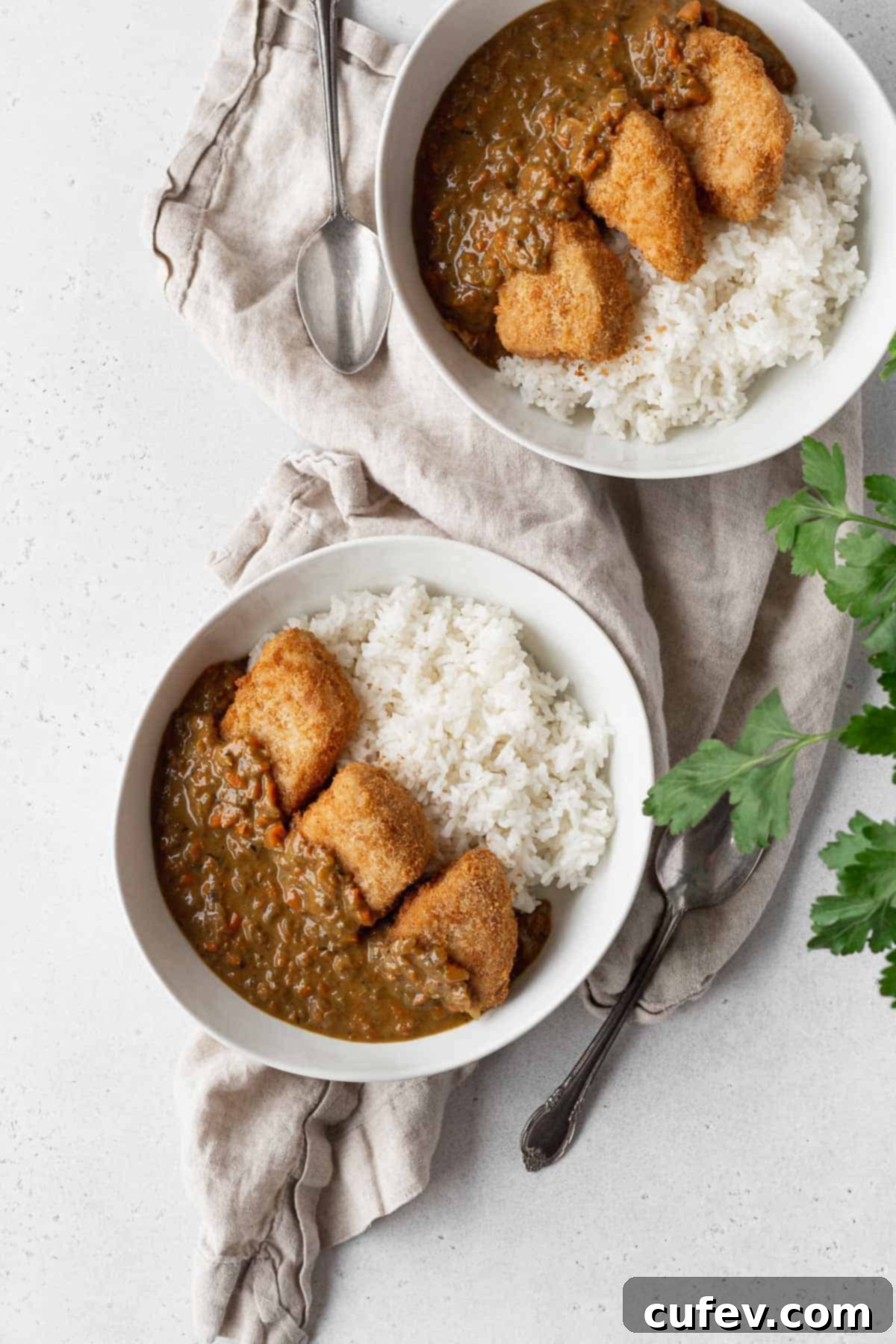
Why You’ll Adore This Vegan Japanese Curry:
This Japanese vegan katsu curry recipe isn’t just a meal; it’s an experience. It’s the ultimate plant-based comfort food, designed to satisfy your deepest cravings for something spicy, flavorful, and incredibly fulfilling. Beyond its undeniable deliciousness, here are compelling reasons why this vegan curry recipe is destined to become a staple in your kitchen:
- Effortlessly Delicious: While this recipe involves three distinct components – the fluffy rice, the aromatic curry sauce, and the crispy katsu – don’t let that intimidate you. Each step is surprisingly straightforward, making it an accessible culinary project for home cooks of all skill levels. With a little time and attention, you’ll master this dish and impress everyone at your table.
- Thoughtfully Allergen-Friendly: We’ve crafted this curry to be inclusive and accommodating. Not only is it completely vegan, but it’s also naturally nut-free and soy-free, catering to common dietary restrictions. For those with gluten sensitivities, it’s incredibly easy to adapt; simply refer to our detailed notes below for simple modifications to make this entire meal gluten-free without compromising on taste or texture.
- Hearty and Wholesome: This isn’t just another light meal; it’s a robust and substantial dish designed to deeply satisfy. The combination of nutrient-rich vegetables in the curry, the protein-packed jackfruit katsu, and the energy from steamed rice ensures that every bowl is incredibly filling and sustaining. If you’re searching for a meal that truly sticks to your ribs and keeps you feeling full and content for hours, your quest ends here.
- Rich and Complex Flavors: The curry sauce is a symphony of spices, slow-cooked to perfection, creating a depth of flavor that is both comforting and exciting. Paired with the mild, slightly sweet notes of jackfruit and the crisp texture of panko, every bite is a delightful journey for your taste buds.
- Customizable Comfort: From adjusting the spice level to experimenting with secret ingredients, this recipe is a fantastic canvas for personalization. You can tailor it precisely to your preferences, making it uniquely yours every time.
Essential Ingredients for Vegan Katsu Curry
Achieving the profound flavor of this katsu curry is simpler than you might think, thanks to the power of yellow curry paste and garam masala, both brimming with an array of aromatic spices. Here’s a breakdown of the key ingredients that bring this vegan Japanese comfort food to life:

- Onion & Carrot: These foundational aromatics form the sweet and savory base of our curry sauce. Finely chopping them allows them to melt into the sauce, creating a smooth consistency, but dicing them can introduce a pleasant texture. A food processor can make this step quick and easy, or a sharp chef’s knife works just as well for those who enjoy the meditative rhythm of chopping.
- Garlic: Essential for any rich curry, freshly grated or crushed garlic provides a pungent, aromatic kick that permeates the sauce. Grating or crushing ensures a smoother mouthfeel, integrating seamlessly into the curry. Jarred minced garlic is a convenient alternative if you’re short on time.
- Thyme & Bay Leaves: These two classic herbs might seem unexpected in a Japanese curry, but they contribute a wonderful depth, a subtle earthiness, and a lovely aroma that elevates the overall complexity of the sauce.
- Garam Masala: This essential spice blend plays a crucial role in bridging the flavor gap between Thai yellow curry paste and traditional Japanese curry. Garam masala, a warm and fragrant Indian spice mix, introduces many of the missing spices, transforming the profile into something distinctly Japanese-inspired. This particular blend is highly recommended for its quality and flavor.
- Yellow Curry Paste: Chef’s Choice yellow curry paste is the cornerstone of our curry’s vibrant flavor. It’s a meticulously crafted blend of various herbs and spices, offering a complex and spicy foundation that is both authentic and incredibly delicious.
- Coconut Milk: For a lusciously creamy and smooth curry, Chef’s Choice coconut milk is an excellent choice. Made with just two pure ingredients – coconut and water – it delivers rich creaminess without any unwanted additives, providing the perfect body for our sauce.
- Vegetable Stock: This liquid base forms the bulk of the curry sauce, infusing it with savory notes. You can opt for a high-quality store-bought vegetable stock, prepare your own homemade broth for unparalleled freshness, or use a vegetable paste diluted with water for convenience.
- Coconut Aminos: A fantastic soy-free alternative, coconut aminos offer a balanced blend of umami and subtle sweetness. It mimics the savory depth of soy sauce while adding a unique sweet note. This brand and this one are personal favorites for their rich flavor profile.
- Jackfruit Confit: Nature’s Charm young green jackfruit confit is the star of our vegan katsu. Marinated and cooked to tenderness, it provides an incredible “meaty” texture that perfectly mimics traditional katsu. This recipe cleverly utilizes not only the jackfruit for the cutlets but also the flavorful confit oil to sauté the onions and carrots, adding an extra layer of richness to the curry base.
- Oat Flour: A versatile and often gluten-free option, oat flour (simply ground oats!) serves a dual purpose here: it coats the jackfruit pieces before breading, ensuring good adhesion, and when mixed with water, it creates the perfect “egg wash” substitute to bind the panko breadcrumbs.
- Panko Breadcrumbs: Absolutely indispensable for authentic katsu, panko provides an unparalleled light, airy, and extra-crispy coating. Store-bought panko is widely available, but for a truly superior gluten-free katsu, I highly recommend grating frozen slices of your favorite gluten-free bread yourself, as commercial gluten-free panko often falls short in texture.
Smart Ingredient Substitutions
While the recipe is designed for optimal flavor and texture, sometimes you might need to make a swap or two. Here are some smart substitutions that won’t compromise the deliciousness of your vegan katsu curry:
- Coconut Aminos: If coconut aminos aren’t readily available, you can easily substitute them with regular soy sauce. Keep in mind that soy sauce is typically saltier than coconut aminos, so start by adding just ½ teaspoon at a time. Taste the curry after each addition and adjust until it reaches your preferred level of seasoning. If you want to replicate the subtle sweetness of coconut aminos, a tiny dash of sugar or agave syrup can be added along with the soy sauce.
- Jackfruit Confit: Nature’s Charm young green jackfruit confit is ideal, but if you can’t find it, canned young green jackfruit packed in water or brine is a suitable alternative. Just be sure to drain and rinse it thoroughly, then press out as much excess liquid as possible to achieve the right texture. Another excellent plant-based “meat” substitute is firm or extra-firm tofu. Press the tofu well to remove water, then slice it into katsu-like cutlets and proceed with the breading steps. Tempeh can also work, offering a slightly different, nuttier flavor.
- Oat Flour: This versatile flour is great for gluten-free diets, but if you don’t have it, fear not! All-purpose flour is a perfect 1:1 substitute for both coating the jackfruit and creating the wet binder. For a gluten-free option, a commercial 1-to-1 gluten-free flour blend will work beautifully. Cornstarch or arrowroot powder can also be used as a light coating, although they might create a slightly different texture for the wet binder.
- Yellow Curry Paste: If Chef’s Choice yellow curry paste isn’t on hand, another good quality yellow curry paste can be used. Just be sure to check the ingredients to ensure it’s vegan, as some brands may contain shrimp paste. Adjust the amount to your taste, as spice levels can vary between brands.
Step-by-Step Guide: How to Make Vegan Katsu Curry
Crafting this delightful vegan katsu curry involves two main components: the rich, aromatic curry sauce and the crispy, golden jackfruit katsu. Follow these steps for a perfect meal.
Crafting the Rich Vegan Japanese Curry Sauce
- Begin by heating 2 tablespoons of the flavorful oil from the jackfruit confit (or a neutral oil of your choice) in a sturdy pot or large skillet over medium-low heat. Add the finely chopped onion and carrot. Sauté these vegetables gently for 15-20 minutes, stirring frequently. The goal here is to achieve a beautiful caramelization, which deepens their sweetness and adds incredible depth to the curry base.
- Once the onions and carrots are softened and slightly golden, add the grated garlic, garam masala, and dried thyme to the pot. Cook for just 1 minute more, stirring constantly. This brief cooking time allows the spices to bloom and release their intoxicating aromas, enhancing the overall fragrance and flavor of the curry. Be careful not to burn the garlic.

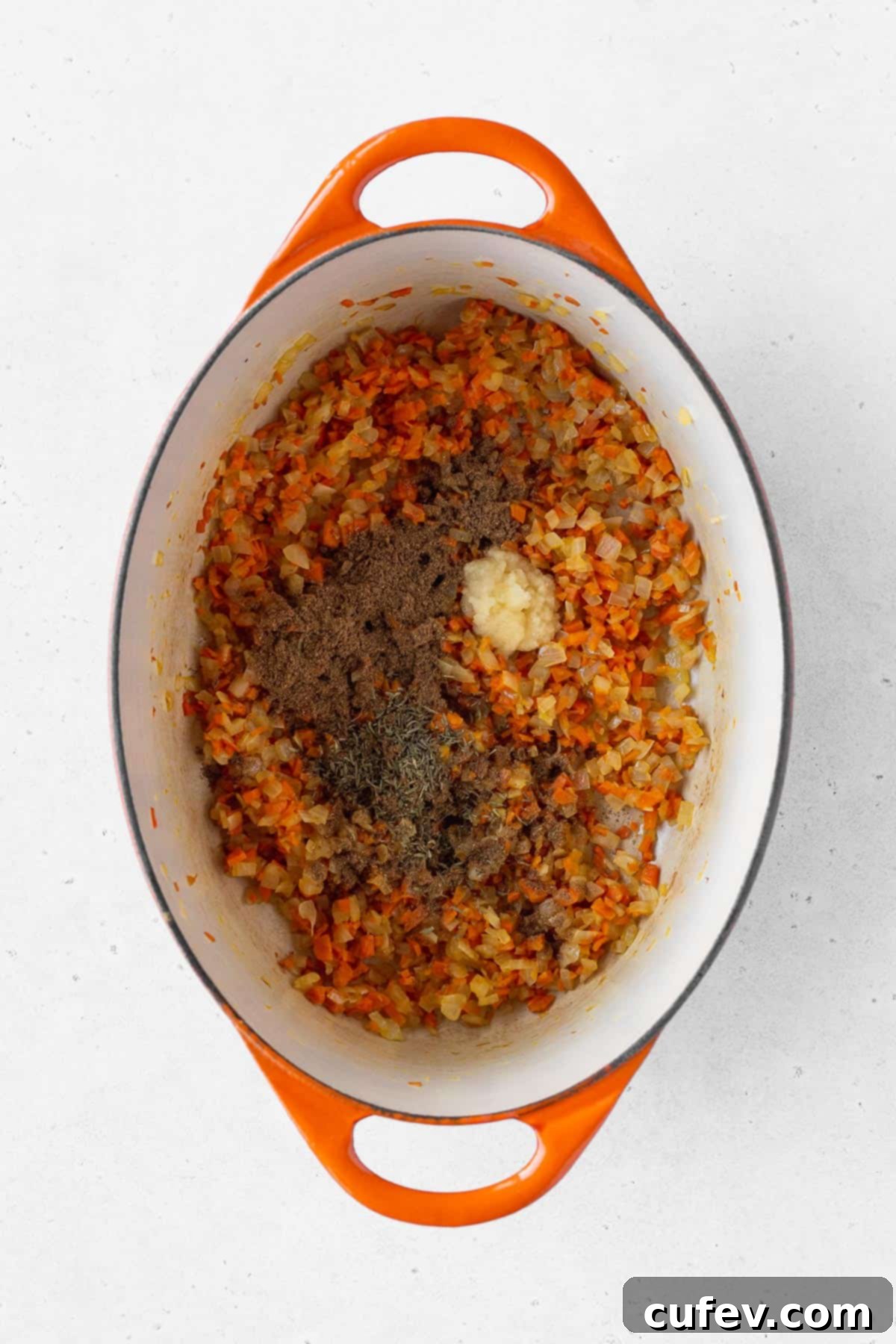
- Next, add the yellow curry paste to the sautéed vegetables and spices. Using a wooden spoon or spatula, thoroughly work the paste into the mixture for about 1 minute. This ensures the curry paste is well-distributed and gently toasted, unlocking its full flavor potential.
- Pour in the creamy coconut milk and savory vegetable stock. Add the two bay leaves, which will slowly release their subtle, aromatic notes as the curry simmers. Bring the mixture to a gentle boil, then reduce the heat to low and let it simmer, uncovered, for 20 minutes. This simmering time allows the flavors to meld beautifully and the sauce to thicken slightly.
- Finally, stir in the coconut aminos. Taste the curry and adjust the seasoning as needed. You might want to add a pinch more salt, a dash of sugar, or a bit more coconut aminos to achieve your perfect balance of sweet, savory, and spicy. Remove the bay leaves before serving.


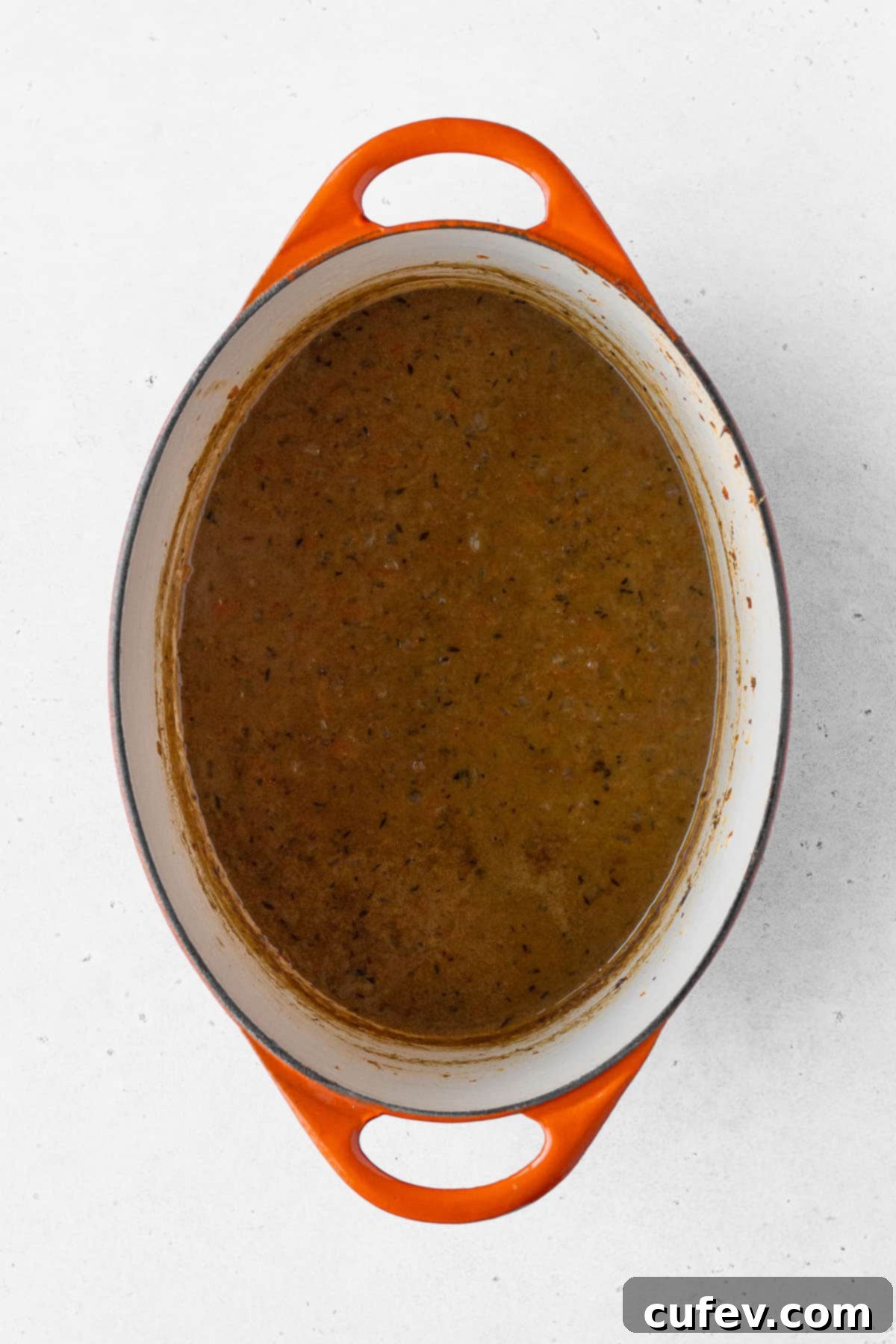
Preparing the Crispy Vegetarian Katsu
- Begin by draining the Nature’s Charm jackfruit confit from its oil. It’s crucial to pat the jackfruit pieces thoroughly dry with paper towels. Removing excess moisture is key to achieving a truly crispy katsu coating.
- In a shallow dish, gently coat each piece of jackfruit with 2 tablespoons of oat flour. Ensure all surfaces are lightly dusted; this initial coating helps the wet binder adhere better.
- Set up your breading station: In one bowl, whisk together the remaining 2 tablespoons of oat flour with 4 tablespoons of water to create a slurry – this acts as your vegan “egg wash.” In another shallow bowl or plate, spread out the panko breadcrumbs. Dip a floured jackfruit piece into the oat flour and water mixture using one hand (keeping it “wet”), then immediately transfer it to the panko breadcrumbs. Use your other hand (keeping it “dry”) to thoroughly coat the wet jackfruit with panko, gently pressing down to ensure the breadcrumbs adhere firmly. Repeat this process with all the jackfruit pieces.

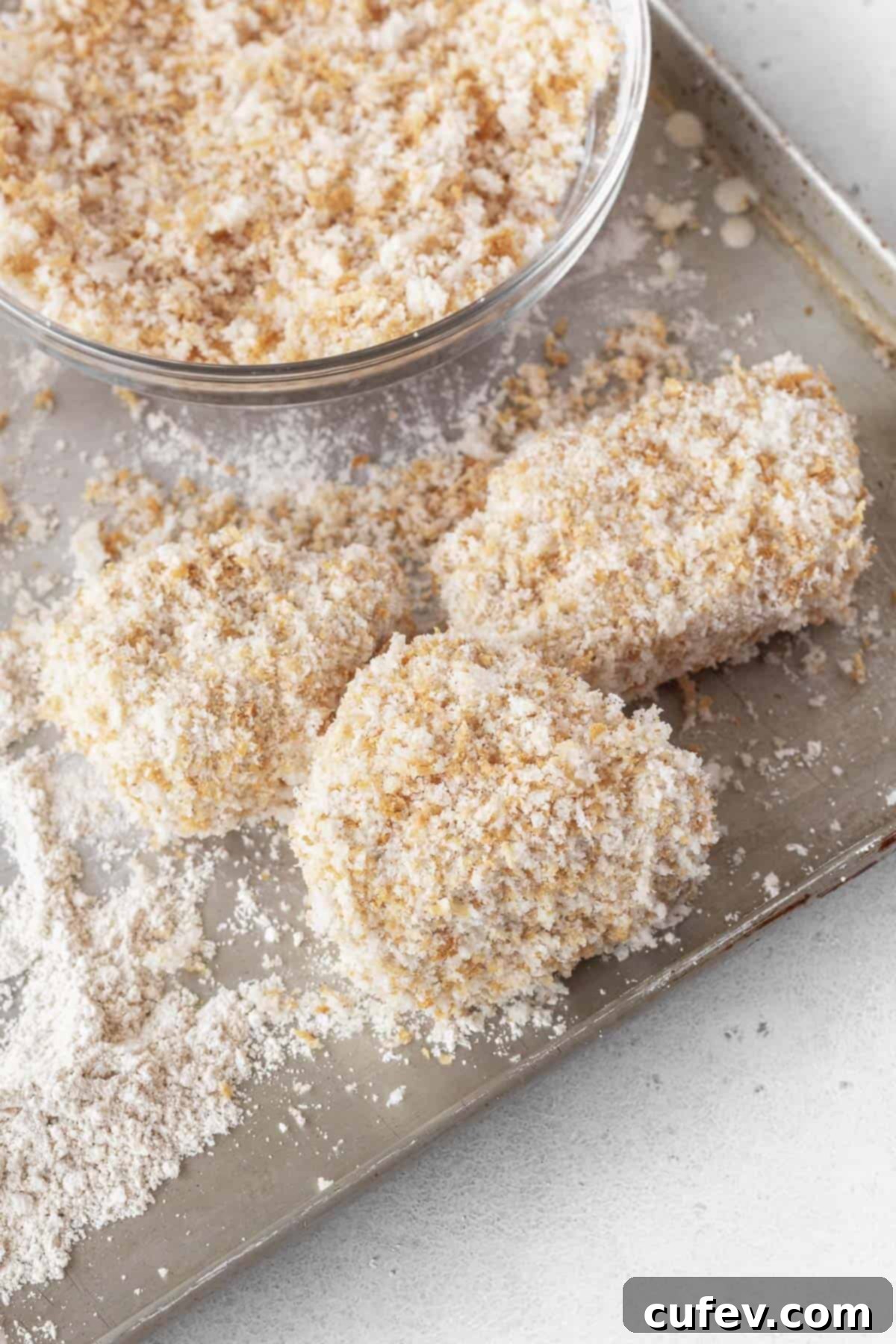
- Heat approximately 2 inches (5 cm) of frying oil in a deep pan or Dutch oven over medium-high heat. Use a kitchen thermometer to monitor the oil temperature, aiming for a steady 340°F (170°C). Maintaining the correct temperature is vital for crispy, non-greasy katsu.
- Carefully add a few breaded jackfruit pieces to the hot oil, ensuring not to overcrowd the pan. Fry for about 1 minute on each side, or until they achieve a beautiful, even golden-brown color and are wonderfully crispy. Work in batches if necessary to keep the oil temperature stable.
- Once fried to perfection, remove the deep-fried katsu from the oil using a slotted spoon or tongs. Place them immediately on a wire rack set over a baking sheet to allow any excess oil to drip away, ensuring they remain exceptionally crispy.
- Serve your freshly fried vegan katsu in a bowl or on a plate alongside hot steamed rice and a generous ladle of the prepared vegan Japanese curry sauce. For the best experience, serve immediately while the katsu is at its crispiest!
Exciting Recipe Variations for Your Palate:
While this vegan katsu curry recipe is undeniably delicious as is, its versatility allows for exciting customization to perfectly suit your taste preferences. Many Japanese home cooks have their own “secret ingredient” to enhance the curry’s depth and complexity. These additions might sound unconventional, but typically only a teaspoon or two is used to provide a subtle, intriguing hint of flavor. Here are some creative ideas to elevate your curry:
- Applesauce or Grated Apple: For a gentle, natural sweetness that balances the savory and spicy notes, stir in a spoonful of unsweetened applesauce or finely grated apple during the simmering phase. This adds a fruity complexity without making the curry overtly sweet.
- Agave Syrup or Maple Syrup: If you prefer a more controlled sweetness (or if you’re not vegan, a touch of honey), a teaspoon or two of agave or maple syrup can round out the flavors beautifully. Add it gradually and taste as you go to achieve your desired sweetness.
- Vegan Butter: To impart an extra layer of richness, umami, and a wonderfully silky texture to your curry, swirl in a tablespoon of high-quality vegan butter towards the end of the simmering process. It adds a luxurious mouthfeel that is truly comforting.
- Red Wine: A small splash (about 1-2 tablespoons) of dry red wine, added after sautéing the vegetables and before adding liquids, can contribute a sophisticated depth of flavor and subtle tanginess to the curry. Let it reduce slightly to cook off the alcohol.
- Dark Chocolate: This might be the most surprising “secret ingredient,” but a small piece (about half an ounce) of unsweetened or very dark chocolate (70% cocoa or higher, *not* sweet milk chocolate) can add an incredible richness and subtle bitterness that balances the curry, lending it a profound, almost mysterious depth. Melt it into the sauce during the final minutes of simmering.
- Coffee or Espresso Powder: For an even deeper, roasted flavor, a tiny pinch (1/4 teaspoon) of instant coffee or espresso powder can be stirred in. It enhances the savoriness and dark notes of the curry without tasting like coffee.
- Miso Paste: A teaspoon of white or yellow miso paste, dissolved in a little warm water before adding to the curry, can introduce an incredible layer of umami and a slight fermented tang, enriching the overall flavor profile.
Expert Pro-Tips for Perfect Vegan Katsu Curry
Achieving a truly exceptional vegan katsu curry involves a few key techniques that can elevate your dish from good to extraordinary. Keep these professional tips in mind for the best results:
- Master the Caramelized Onions: This step is non-negotiable for a deeply flavorful curry. Taking the time to slowly cook the onions until they are beautifully caramelized (a process often taking 15-20 minutes over medium-low heat) unlocks their natural sugars, imparting a profound sweetness and rich, complex flavor to the curry sauce. This natural sweetness is crucial for balancing the spicy notes and creating that authentic Japanese curry depth. Don’t rush it!
- Press the Panko Firmly: When breading your jackfruit chunks, ensure you gently but firmly press the panko breadcrumbs onto every surface. This crucial step creates a thick, even coating that adheres well during frying, preventing the breadcrumbs from falling off and ensuring maximum crispiness. A well-adhered panko coating is what gives katsu its signature crunch.
- Allow the Curry to Rest Overnight: This is arguably the most impactful pro-tip for Japanese curry. While you can certainly enjoy the curry immediately after cooking, letting it rest in the fridge overnight (or even for several hours) allows the flavors to deepen, meld, and mature. The spices become more integrated, and the sauce often develops a slightly milder, sweeter, and more harmonious profile. It’s a transformative step that truly enhances the curry’s complexity.
- Maintain Optimal Oil Temperature: For perfectly crispy and non-greasy katsu, always use a thermometer to maintain your frying oil at 340°F (170°C). If the oil is too cold, the katsu will absorb too much oil and become greasy. If it’s too hot, the breading will burn before the jackfruit is heated through. Fry in small batches to prevent the oil temperature from dropping too significantly.
- Double-Breading for Extra Crunch: For an even thicker and crispier katsu coating, consider double-breading. After the first coat of oat flour and panko, dip the katsu back into the oat flour-water mixture and then into the panko again. This creates an extra-crunchy exterior that stands up wonderfully to the curry sauce.

Delicious Serving Suggestions:
This jackfruit katsu curry is a hearty meal on its own, traditionally served with a mound of hot, steamed white rice. To truly complete the authentic Japanese experience, consider garnishing your dish with fukujinzuke, which are thinly sliced, vibrantly red pickled radishes. Their sweet and tangy crunch provides a delightful contrast to the rich curry. You can also add a sprinkle of chopped scallions or a drizzle of vegan Tonkatsu sauce for extra layers of flavor.
While Japanese curry is enjoyed year-round, its comforting warmth makes it especially appealing during the colder months. Imagine cozying up with a steaming bowl of this rich curry and crispy katsu – it’s the perfect antidote to a chilly day, offering both warmth and deep satisfaction.
Frequently Asked Questions About Vegan Katsu Curry
Absolutely! The curry sauce is an ideal component to prepare in advance. In fact, its flavors often deepen and become even more complex and harmonious if allowed to rest. You can make the vegan curry sauce up to 3 days ahead of time and store it securely in an airtight container in the refrigerator. When you’re ready to serve, simply reheat it gently on the stovetop. However, I strongly advise against preparing the katsu cutlets in advance. Freshly fried katsu is paramount for that signature crispiness. If you store fried katsu in the fridge, it will inevitably lose its desired crunch and become soggy. For the ultimate texture, always fry the katsu just before serving.
Katsu curry is a specific and highly popular variation of Japanese curry, rather than being an entirely different dish. The fundamental difference lies in the addition of “katsu.” Regular Japanese curry typically features various vegetables (like potatoes, carrots, onions) and often meat (such as beef or chicken) simmered directly within the thick curry sauce itself. Katsu curry, on the other hand, typically has a meat-free curry sauce, with the star attraction – the crispy, breaded cutlet (katsu) – served separately on top of the rice, alongside the curry sauce. So, while they share the same delicious curry base, the presentation and inclusion of the breaded cutlet define katsu curry.
It’s a common misconception that all curry pastes are naturally vegan, but unfortunately, this is not always the case. The vegan status of curry paste can vary significantly depending on the specific type of curry and the brand producing it. Many traditional Southeast Asian curry pastes, particularly Thai red and green curry pastes, often include shrimp paste (kapi) or fish sauce as key ingredients for depth of flavor. Even some yellow curry pastes might contain non-vegan components. Therefore, it is absolutely essential to carefully check the ingredient list on the packaging to confirm that the curry paste is free from any animal-derived products. The Chef’s Choice yellow curry paste I recommend and use in this specific recipe is certified vegan, making it a safe and delicious choice for plant-based diets.
Yes, you can! While deep-frying yields the crispiest results, baking or air frying are excellent healthier alternatives. To bake, preheat your oven to 400°F (200°C). Place the breaded jackfruit katsu on a wire rack set over a baking sheet and lightly spray with oil. Bake for 20-25 minutes, flipping halfway, until golden and crisp. For air frying, preheat to 375°F (190°C), lightly spray the katsu with oil, and air fry for 10-15 minutes, flipping halfway, until beautifully golden and crunchy. Results will vary slightly in crispness compared to deep-frying, but they will still be delicious.
For an authentic Japanese katsu curry experience, short-grain Japanese rice (sometimes labeled as sushi rice) is the preferred choice. This type of rice cooks up to be wonderfully fluffy, slightly sticky, and absorbent, making it perfect for soaking up the rich curry sauce. Medium-grain rice can also work as a good alternative if short-grain Japanese rice is unavailable. Avoid long-grain rice varieties like basmati or jasmine, as their drier, less sticky texture doesn’t complement the curry in the same way.
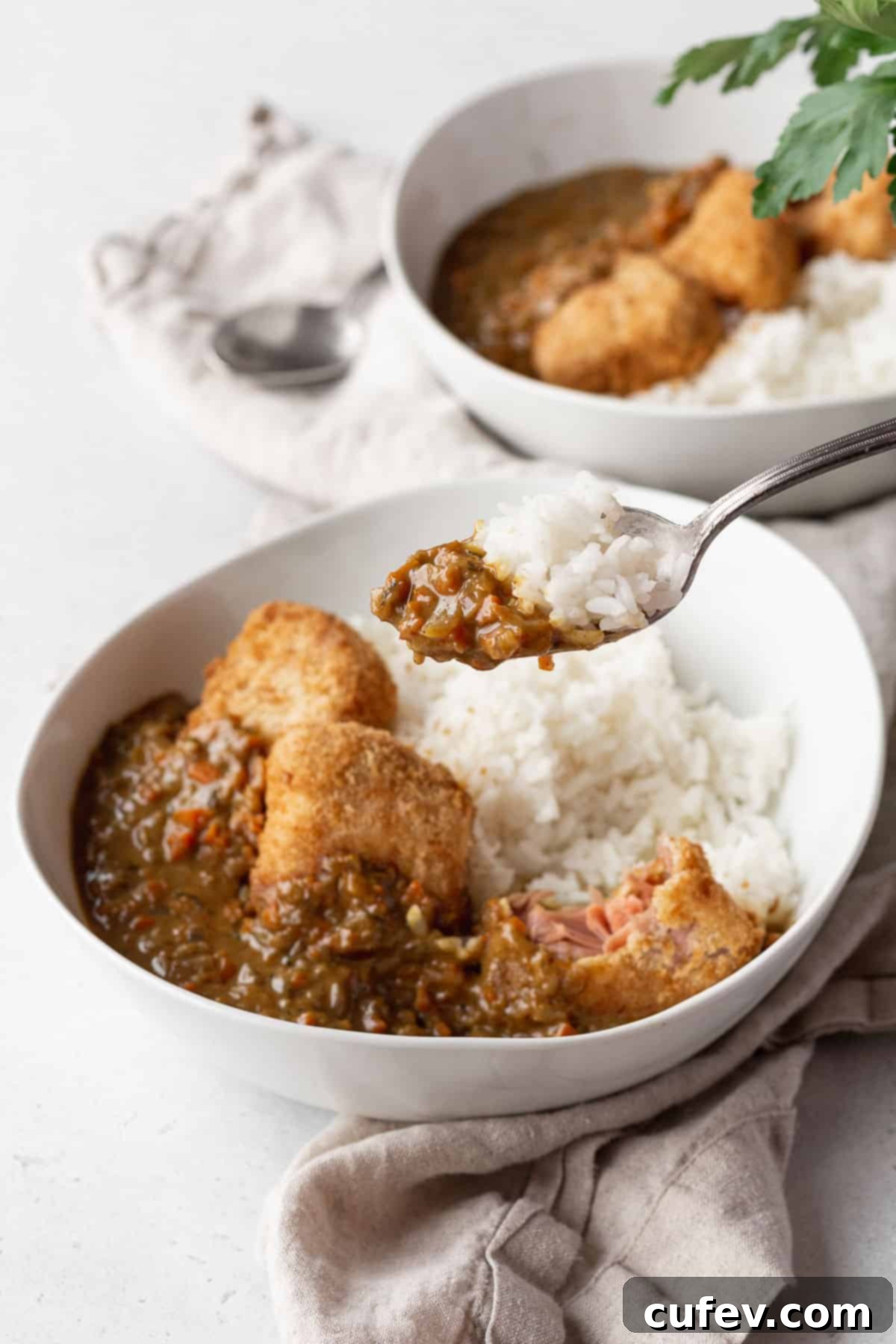
Storing and Reheating Your Katsu Curry:
Proper storage ensures you can enjoy your delicious vegan katsu curry for days to come. However, it’s important to store the components separately to maintain their best qualities.
For the Curry Sauce: The vegan Japanese curry sauce stores exceptionally well. Transfer any leftover curry into an airtight container and refrigerate it for up to 3 days. For longer storage, the curry sauce freezes beautifully. You can keep it in the freezer for about a month. To reheat, thaw overnight in the fridge if frozen, then gently warm on the stovetop over low heat, stirring occasionally, until heated through. You might need to add a splash of vegetable stock or water to reach your desired consistency.
For the Jackfruit Katsu: The jackfruit katsu is at its peak crispiness immediately after frying. It tends to lose its crunch when refrigerated, becoming softer. For this reason, it’s best not to make the katsu too far ahead of time or store already fried katsu in the fridge if you’re aiming for that fresh crunch. That said, if you do find yourself with leftover fried katsu, you can store them in an airtight container in the freezer. When you’re ready to enjoy them again, there’s a simple way to revive their crispness: place the frozen katsu pieces on a baking sheet and bake them in a preheated oven at 350°F (175°C) for approximately 30 minutes, or until thoroughly heated and re-crisped.
For Steamed Rice: Store leftover steamed rice in an airtight container in the refrigerator for up to 2-3 days. Reheat gently in the microwave with a splash of water, or steam it again to restore its fluffiness.
Tools You’ll Need for This Recipe:
You won’t need any specialized kitchen gadgets to whip up this amazing vegan katsu curry. Just a few basic tools will suffice, making this recipe accessible for any home cook:
- Chef’s Knife: An indispensable tool for finely chopping your onions and carrots, and prepping the jackfruit. A sharp knife makes all the difference in prep work.
- Cutting Board: Essential for safe and efficient vegetable preparation. Choose a sturdy board that won’t slip.
- Pot or Large Skillet: A heavy-bottomed pot or a large skillet with deep sides is perfect for simmering the curry sauce and maintaining even heat distribution. A Dutch oven works wonderfully here.
- Wooden Spoon or Spatula: Ideal for stirring the curry, scraping the bottom of the pot, and working the curry paste into the vegetables without scratching your cookware.
- Wire Rack: Crucial for draining excess oil from your freshly fried katsu, ensuring they stay delightfully crispy. Place it over a baking sheet for easy cleanup.
- Shallow Bowls/Plates: You’ll need at least three for your breading station (one for oat flour, one for the wet mixture, and one for panko).
- Deep Fryer or Deep Pan: For deep-frying the katsu. A sturdy pot with high sides is important for safety.
- Kitchen Thermometer: While not strictly essential, a deep-fry thermometer is highly recommended to accurately monitor the oil temperature, which is key for perfectly crispy, non-greasy katsu.

More Delightful Vegan Japanese Recipes
If you’ve enjoyed this delicious journey into vegan Japanese comfort food, there’s a whole world of plant-based Japanese cuisine waiting to be explored! Here are some other fantastic vegan Japanese recipes that are sure to tantalize your taste buds and expand your culinary repertoire:
- Vegan Japanese Cream Stew: A rich, creamy, and hearty stew perfect for chilly evenings.
- Vegan Macaroni Gratin: A cheesy, comforting baked pasta dish, Japanese-style.
- Kashiwa Mochi: Traditional Japanese rice cakes filled with sweet bean paste, often enjoyed during Children’s Day.
- Shiratama Dango: Soft, chewy mochi dumplings, wonderfully versatile for sweet or savory applications.
If you made my jackfruit curry recipe and loved it, I would be absolutely thrilled to hear your thoughts! Please consider leaving a star rating and a comment below to share your experience. Your feedback is invaluable and helps others discover this delicious plant-based meal. You can also tag me on your social posts (@aimadeitforyou) so I can celebrate your culinary success from afar!
For even more delightful gluten-free and dairy-free recipe inspiration, be sure to follow me on Instagram, Pinterest, Facebook, and YouTube. And don’t miss out on any of my newest content – sign up for my email newsletter to get all the latest recipes and tips delivered straight to your inbox!

Japanese Vegan Katsu Curry
Main Course
Japanese
15 minutes
40 minutes
55 minutes
2
bowls
870
kcal
Ai Willis
Print
Pin
Rate
Metric
Ingredients
For the Vegan Japanese Curry Sauce
- 1 medium onion , finely chopped for a smooth sauce
- 2 carrots , finely chopped (or diced for more texture)
- 2 garlic cloves , grated or crushed
- 2 tablespoons Chef’s Choice yellow curry paste , ensures rich, authentic flavor
- 13.5 oz Chef’s Choice coconut milk , for creamy richness
- 2 teaspoons garam masala , crucial for Japanese curry spice profile
- 2 bay leaves , for aromatic depth
- ½ cup vegetable stock , homemade or store-bought
- 1 teaspoon dried thyme , adds a subtle earthy aroma
- 2 teaspoons coconut aminos , for umami and a hint of sweetness (or soy sauce + sugar)
- 2 tablespoons jackfruit confit oil (from Nature’s Charm jackfruit confit, or other neutral oil)
For the Crispy Vegan Katsu
- 2 cans Nature’s Charm young green jackfruit confit , drained and patted dry
- 4 tablespoons oat flour , divided for coating and slurry (use all-purpose or GF blend as substitute)
- 4 tablespoons water , for the “egg wash” slurry
- 1½ cups panko breadcrumbs , for ultimate crispiness (use grated GF bread for gluten-free)
- 2 inches frying oil (e.g., canola, vegetable, or sunflower oil)
To Serve
- Steamed Japanese rice , freshly prepared
- Fukujinzuke (red pickled radish), optional, for a classic garnish
- Fresh parsley or chopped scallions , for garnish
Instructions
Crafting the Vegan Japanese Curry Sauce
-
In a pot or large skillet, heat 2 tablespoons of the reserved jackfruit confit oil (or other neutral oil) over medium-low heat. Add the finely chopped onion and carrot, and sauté for 15-20 minutes, stirring frequently, until they become soft and begin to caramelize to a golden hue. This step is crucial for flavor depth.
-
Stir in the grated garlic, garam masala, and dried thyme. Cook for another 1 minute, continuing to stir, allowing the spices to become fragrant without burning.
-
Add the yellow curry paste and work it into the vegetable mixture using a wooden spoon or spatula for 1 minute, ensuring it’s well combined.
-
Pour in the coconut milk and vegetable stock, then add the 2 bay leaves. Bring the mixture to a boil, then reduce the heat to low and let it simmer for 20 minutes, allowing the flavors to meld and the sauce to thicken. Finally, stir in the coconut aminos and taste for seasoning, adjusting as needed. Remove bay leaves before serving.
Preparing the Crispy Vegan Katsu
-
Drain the jackfruit confit thoroughly and pat each piece very dry with paper towels to ensure a crispy coating.
-
In a shallow dish, coat the dry jackfruit pieces with 2 tablespoons of oat flour, ensuring an even, light dusting.
-
Prepare your breading station: In one bowl, whisk the remaining 2 tablespoons of oat flour with 4 tablespoons of water to create a smooth slurry. In a separate bowl or plate, spread out the panko breadcrumbs. Dip a floured jackfruit piece into the wet oat flour mixture using one hand, then transfer it to the panko breadcrumbs. Use your other hand to firmly press and coat the jackfruit completely with panko. Repeat with all remaining jackfruit pieces.
-
Heat frying oil (about 2 inches or 5 cm deep) in a pan to 340°F (170°C). Carefully add a few breaded jackfruits into the hot oil, ensuring not to overcrowd the pan. Fry for approximately 1 minute per side until they turn a beautiful golden-brown and are crispy.
-
Using a slotted spoon, remove the deep-fried katsu from the oil and place them on a wire rack set over a baking sheet to drain any excess oil. This helps maintain maximum crispness.
-
Serve the crispy vegan katsu immediately in a bowl or on a plate alongside hot steamed rice and generous ladlefuls of the prepared aromatic curry sauce. Garnish with fukujinzuke (pickled radish) and fresh parsley or scallions if desired. Enjoy!
Notes
Fluffy, sticky Japanese rice is the ideal accompaniment to katsu curry. You can steam your rice efficiently in a rice cooker or using a pot on the stovetop. Regardless of your method, always begin by thoroughly rinsing your short-grain Japanese rice under cold running water until the water runs clear, then drain it well. For this recipe, we recommend using 1½ cups (360ml) of rice.
Cooking Rice in a Rice Cooker: Place the rinsed and drained rice into the inner pot of your rice cooker. Add water up to the line marked ‘2’ (approximately 400ml for 1½ cups of rice) or refer to your specific rice cooker’s instructions. Allow the rice to soak in the water for at least 20 minutes before initiating the cooking cycle. This soaking helps produce a more tender and evenly cooked grain.
Cooking Rice on the Stovetop: Transfer the rinsed and drained rice into a heavy-bottomed pot equipped with a tight-fitting lid. Pour in 1⅔ cups (400ml) of cold water and let the rice soak for 30 minutes. After soaking, cover the pot tightly with the lid and place it over medium heat. Once the water reaches a rolling boil, reduce the heat to the lowest setting, ensuring the lid remains firmly on. Cook for 12 minutes, or until all the water has been completely absorbed by the rice. Do not lift the lid during this time. Once cooked, remove the lidded pot from the stove and let it rest, undisturbed, for an additional 10 minutes. This final steaming step allows the rice to fully fluff up and ensures perfect texture.
Love this recipe?
Snap a photo and share tagging @aimadeitforyou or tag #aimadeitforyou!
Nutrition
Serving:
1
bowl
|
Calories:
870
kcal
|
Carbohydrates:
77
g
|
Protein:
16
g
|
Fat:
58
g
|
Saturated Fat:
39
g
|
Polyunsaturated Fat:
2
g
|
Monounsaturated Fat:
3
g
|
Sodium:
1803
mg
|
Potassium:
859
mg
|
Fiber:
8
g
|
Sugar:
9
g
|
Vitamin A:
10344
IU
|
Vitamin C:
11
mg
|
Calcium:
176
mg
|
Iron:
10
mg
